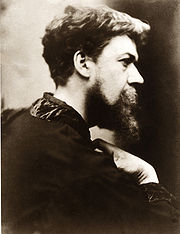
David Wilkie Wynfield
Encyclopedia

Wynfield was distantly related to the Scottish artist David Wilkie
David Wilkie (artist)
Sir David Wilkie was a Scottish painter.- Early life :Wilkie was the son of the parish minister of Cults in Fife. He developed a love for art at an early age. In 1799, after he had attended school at Pitlessie, Kettle and Cupar, his father reluctantly agreed to his becoming a painter...
, after whom he was named. Born in India, he was originally intended by his family for the priesthood, but instead chose art as a profession. He studied at Leigh's art school in the 1850s and his first painting was accepted for the Royal Academy
Royal Academy
The Royal Academy of Arts is an art institution based in Burlington House on Piccadilly, London. The Royal Academy of Arts has a unique position in being an independent, privately funded institution led by eminent artists and architects whose purpose is to promote the creation, enjoyment and...
summer exhibition in 1859.
Wynfield associated with a group of other artists who became known as the St. John's Wood Clique. Their work typically took the form of anecdotal historical narratives. Wynfield himself painted many works set in Medieval or Renaissance Europe, concentrating on romantic problems of couples.
In the 1860s Wynfield became interested in photography. He developed a technique of shallow-focus portrait photography which he passed on to Julia Margaret Cameron
Julia Margaret Cameron
Julia Margaret Cameron was a British photographer. She became known for her portraits of celebrities of the time, and for photographs with Arthurian and other legendary themes....
, who later acknowledged him as the main influence on her own work, writing that "to my feeling about his beautiful photography I owed all my attempts and indeed consequently all my success".
Many of Wynfield's photographs portrayed members of the St. John's Wood Clique and their friends in fancy dress. The combination of soft focus
Soft focus
In photography, soft focus is a lens flaw, in which the lens forms images that are blurred due to spherical aberration. A soft focus lens deliberately introduces spherical aberration in order to give the appearance of blurring the image while retaining sharp edges; it is not the same as an...
, close-up, large-format print and historical costumes produced a photographic style that was completely original at the time. Wynfield was attempting to imitate the painterly effects of old master artists such as Titian
Titian
Tiziano Vecelli or Tiziano Vecellio Tiziano Vecelli or Tiziano Vecellio Tiziano Vecelli or Tiziano Vecellio (c. 1488/1490 – 27 August 1576 better known as Titian was an Italian painter, the most important member of the 16th-century Venetian school. He was born in Pieve di Cadore, near...
, using the new medium. A selection of the photographs was published in 1864 as a book entitled The Studio: A Collection of Photographic Portraits of Living Artists, Taken in the Style of Old Masters, by an Amateur.

